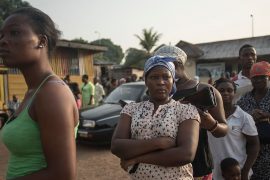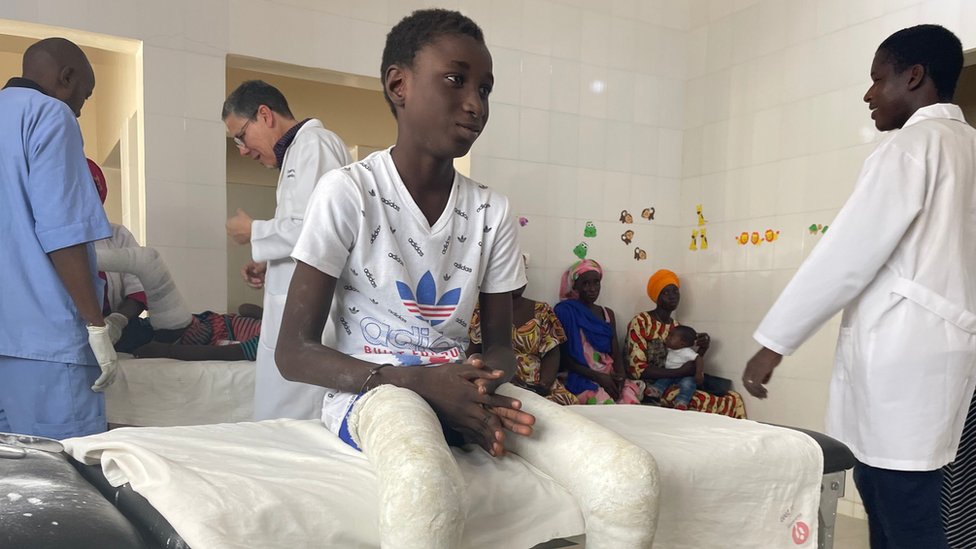
As Africa hold dia first conference on clubfoot – sometin wey dem born about one in 800 pipo across di world wit – BBC visit one health clinic for Senegal to witness one transformative treatment wey dey turn lives around.

Earlier dis year, 14-year-old Serigne bin dey reluctant to eva comot im house. E fit dey waka very slowly, but di boy wey dem born wit both im feet dey point inwards bin dey too ashamed. Some pipo go make fun of di way e dey waka, odas dey afraid and dem go call am names. But now, less dan six months on, im feet don dey transformed and im dream to play football for Senegal dey possible.
- One kind doctor correct neck wey bend, save dis girl life
- ‘My pikin tori ginger me to begin make artificial legs for children wey no fit waka’
Serigne get clubfoot, also known as talipes, and e dey di journey to correct am.
Every year, dem dey born 200,000 babies wit clubfoot. According to di charity MiracleFeet, out of di nearly 10 million pipo alive today wey dem born wit am, as many as eight million neva receive treatment. Compared wit some oda African kontris, Senegal na late adopter of Ponseti – wey be method to correct clubfoot. Dem name di method afta di Spanish doctor wey invent am. Malawi and Uganda, for example, dey ahead of many Western kontris wey recognise Ponseti potential.
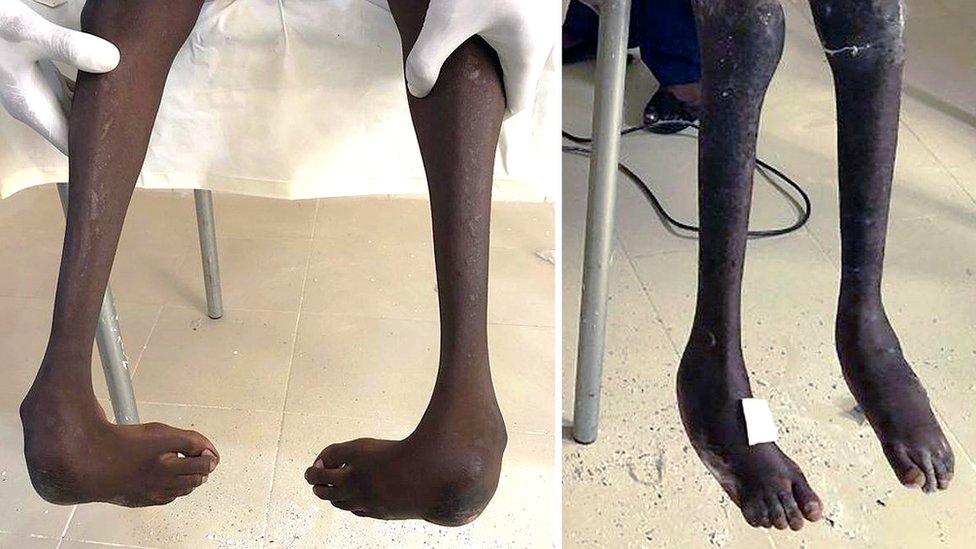
But dis wan mean say Senegalese doctors dem don perfect di original concept and dem don dey use am to treat teenagers or even adults wey tink say dem don pass di age for any intervention.
Serigne mama dey happy about her pikin progress. She sabi di wicked nature of dis disability dan anybodi.
“One time, e no gree comot from house for three days. E cause me so much pain inside. But we don dey happy now.”
As part of di Ponseti method, dem dey put new plaster cast for di leg every week to gradually manipulate di foot into beta position. Sake of say im case dey very strong, e don get 20 casts for many weeks, but di average na between five and eight. Like most cases, towards di end of im treatment, dem require one minor operation to release im Achilles tendon, but odawise dis treatment dey non-invasive.
Beta still, e no cost, and e no need highly-trained surgeon to do am, and e dey extremely effective – 90% of pikin wey dey receive help under di age of two wit routine cases go get good foot function, whereas surgery fit lead to complications. Di changes na truly ogbonge sometin wen you look at di video footage of Serigne waka before di treatment start.
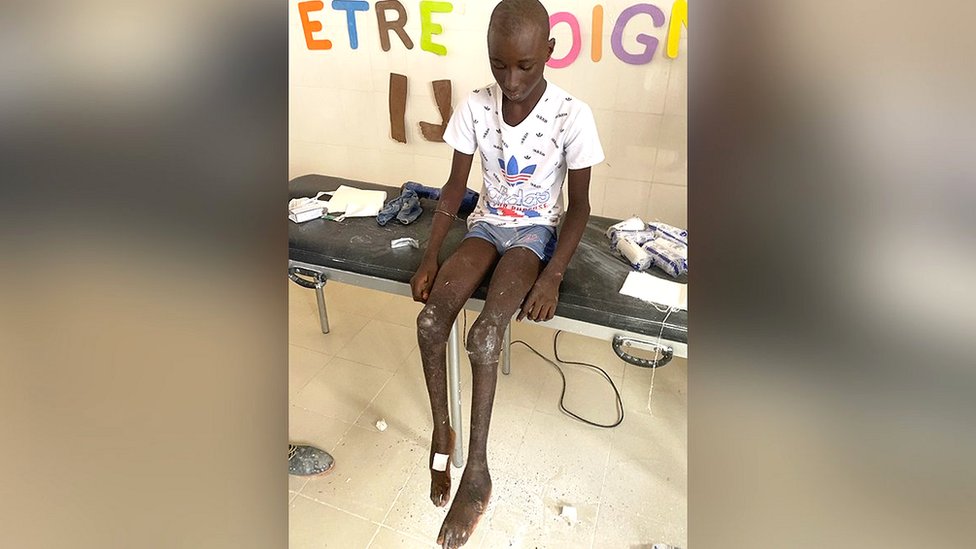
Some days ago, Serigne get im final cast. Afta dat, e go need some physiotherapy to help am learn to bear weight on im legs, and e go need to first wear short leg braces to keep im feet in position, but im future dey very promising.
Fatou, anoda pikin wey dem dey treat for dis Dakar clinic, travel 400 miles (644km) to get di same treatment for her right foot. Today na her 13th birthday but di day dey start wit di removal of her fourth cast. Di nurses see through di plaster and den, in a cloud of dust, dem comot am from her leg. E pain am, but di clinic head nurse, Nicanor Manga reassure am say some pain dey normal and e go worth am at di end.
“We believe say her foot go dey corrected and later on she go fit waka well-well,” e tok. “Really, na joy for us,” e smile. “Wen we lift di cast off and see di good progress, we dey really happy.”
Fatou say sake of say she dey live for remote part of di kontri, she bin neva expect her foot to dey corrected. So she dey happy to dey patient.
School bin dey hard – watching oda pikin run around and jump – whereas Fatou bin dey forced to rely on crutches.
“Everytin wey I bin wan do, I no fit do dem. But once I dey cured, I go dey able to do anytin I want.”
Part of dem na to work towards achieving her new dream of becoming a doctor, her experience don dey positive for here.
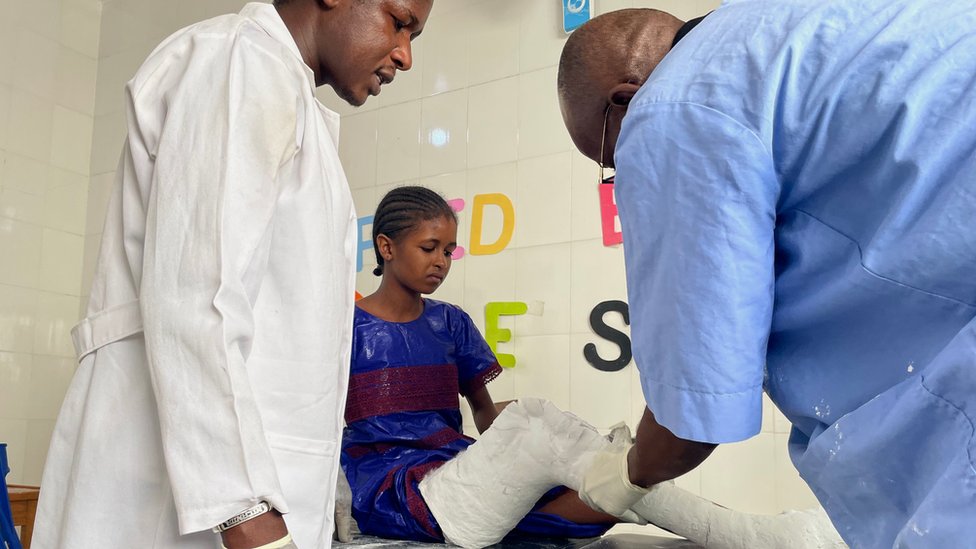
But no be everybodi dey so fortunate. For example, 32 year-old Oumou Barry. Wen we visit her for Lac Rose, one suburb of di Senegalese capital, she show us her left foot, wey dey big and out of shape. She dey waka on di side of her foot, she dey feel pain, she no fit waka far. Her life get mark sake of di stigma of clubfoot, and she wipe her tears as she remember her childhood.
“I dey always ask my mama why I dey like dis? She go ansa me: ‘Na God will’ and ‘We born you like dis.'” Oumou don experience di kind of palava wey stop many families for Senegal from seeking treatment.
- ‘Pipo say I go suffer as I wan marry woman wey no dey see’ – Thankgod Ohaeri
- Nigeria Police announce special provision for pesins with disability
She tok say her toughest time na during her teens, wen her friends begin to wear heels, but she get to stick to sandals. In di end, she drop out of school – sake of say she no fit cope with di bullying again.
Even as she no dey for di midst of classmates wey dey yeye her, life dey tough for am. She also give up on one sewing course wen she discover say operating di sewing machine pedal dey too painful.
Oumou get husband and two pikin dem, so her life no dey as isolated as some wey don dey ostracised sake of clubfoot, but she still feel di limitations of di disability wey don make am unemployed.
“I hold on to notin strong,” she tok as she dey cry.
Unfortunately, due to her age and surgery wey fail, Oumou no fit receive Ponseti treatment. Some adults fit respond well to Ponseti, but e dey more complicated sake of say dia feet dey less flexible.
In most cases, dem still neva fully understand di exact causes of congenital clubfoot, although boys dey likely to dey born wit am dan girls. Di majority of global cases dey for low and middle income kontris, due to high birth rates, and na for poorer kontris di condition dey go likely uncorrected.
One woman wey dedicate her life to make sure say fewer pipo reach adulthood wit clubfoot na Aisha Mballo. Wen we meet her, she dey waka confidently through one market for di town of Thies, one big picture book dey under her arm. Di book explain clubfoot and how di Ponseti method fit correct am. She come here to look for cases of clubfoot wey fit go undetected.
Aisha tok say her own feet bin dey “completely turned backwards” until, for di 1990s wen she dey her mid-teens, dem send am to di US for complex surgery. Now she dey volunteer as ambassador for di charity MiracleFeet, as champion of early screening for newborn pikin dem.
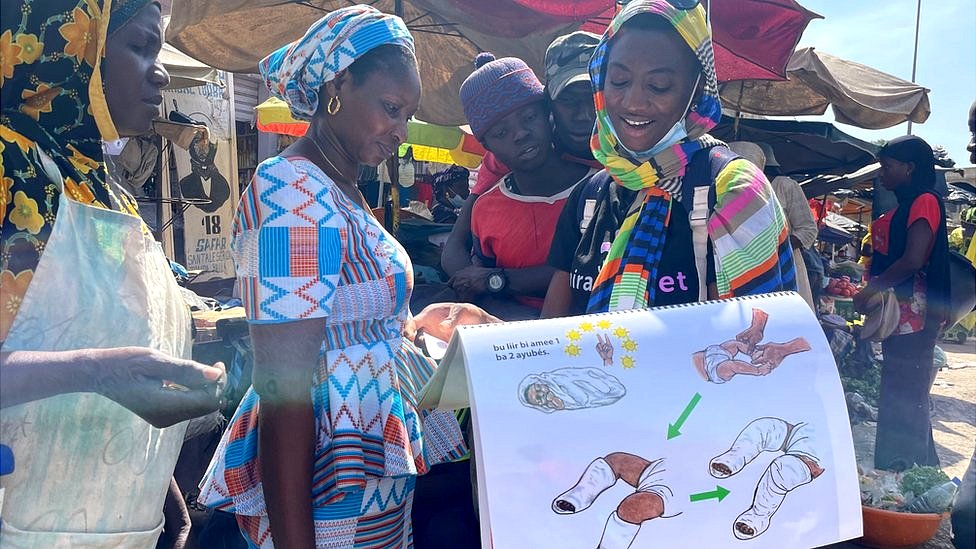
“If pipo recognise di condition and get dia kids out of hiding, we fit get dem to hospital for treatment.”
Rosalind Owen of di Global Clubfoot Initiative, wey don study di perception of clubfoot for Africa, say for traditional communities, “beta problems dey wit stigma”.
“Pipo tink say you dey cursed, or dem use witchcraft for you, or your parents do wrong.” She say dis fit include belief say di mother commit adultery, and dis na di punishment.
Still, fewer dan 20% of clubfoot cases dey receive treatment at birth for Senegal, so a lot of room dey for improvement.
Before we comot Thies, we drop in on anoda clinic to see one two-week-old baby girl wey dey get new plaster cast.
Di doctors and nurses dey wrap bandages around her tiny legs and dem dey smooth down wet plaster on top.
Dis na di perfect time to correct clubfoot.
For di waiting room, one two-year-old boy wey fit wan become footballer dey kick one juice carton around. E dey unsteady as one foot still dey turned inward – but at least e dey get di treatment wey im need.
Photography and additional reporting by Gabriella O’Donnell, Nick Loomis and Borso Tall





